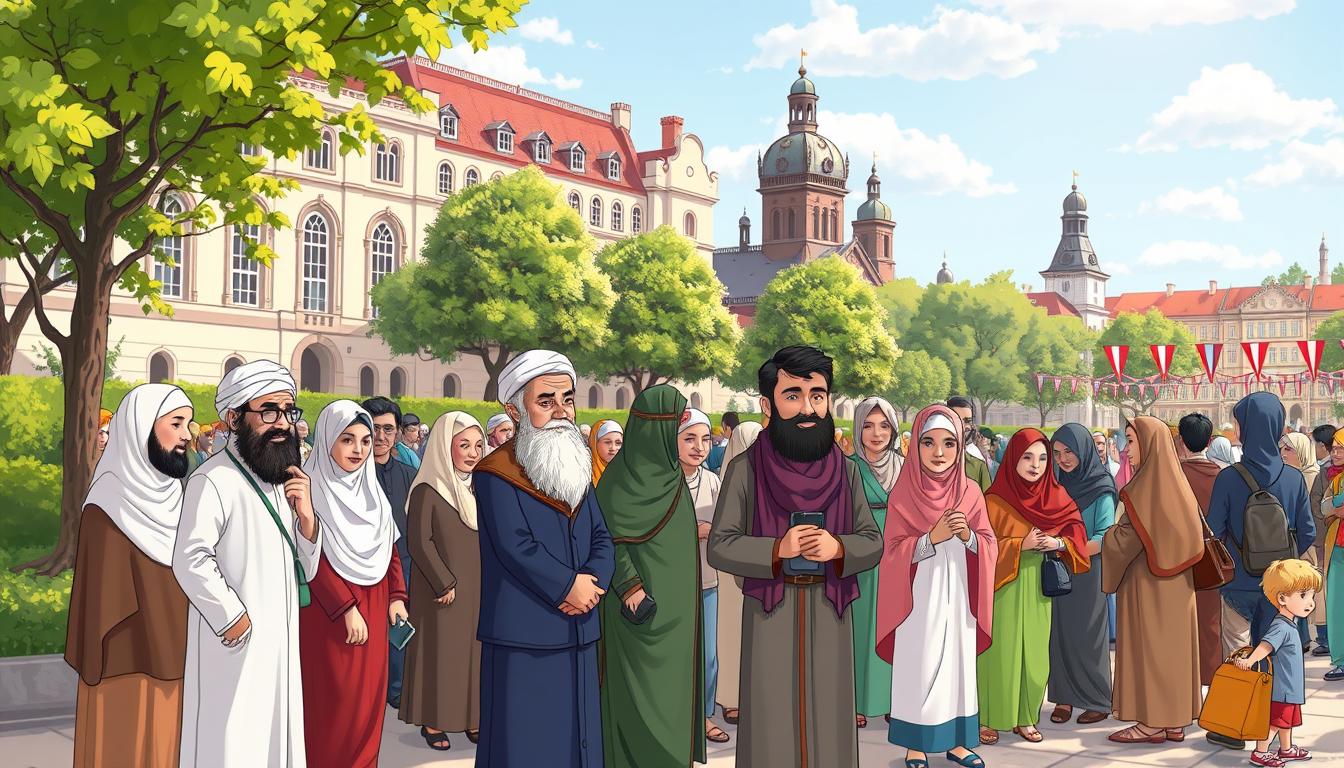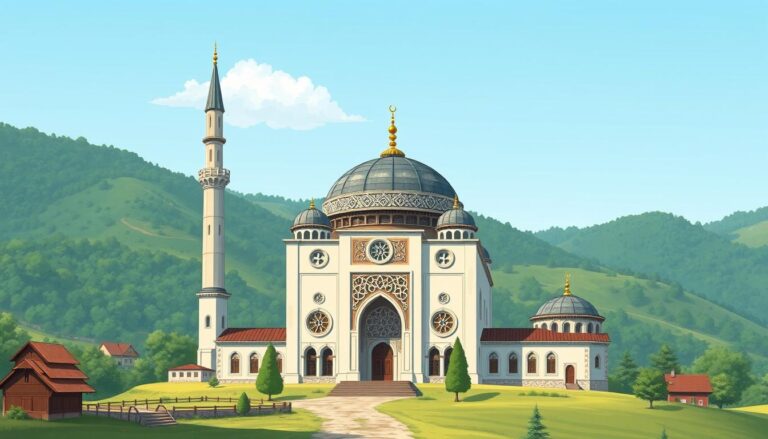Islam in Poland
Tucked away in the heart of Central Europe, Poland is a country with a remarkably diverse history, one that has long intertwined with the presence of Islam. Remarkably, the Muslim population in Poland today constitutes less than 0.1% of the total population, making it one of the countries with the fewest Muslims among those studied in the Brookings project. Yet, this small community’s impact on Polish culture and society has been significant, shaping the country’s religious and political landscape in profound ways.
Key Takeaways
- Islam has had a presence in Poland dating back to the 14th century with the arrival of the Lipka Tatars.
- Muslim communities have become an integral part of Polish society, contributing to its cultural and religious diversity.
- Today, Muslims make up less than 0.1% of Poland’s population, but their role in the country continues to be a topic of significant political and social discourse.
- The Muslim culture in Central Europe has preserved elements of Muslim orthodoxy mixed with religious tolerance and relatively liberal values.
- The presence of Islam in Poland has become a divisive political issue, with the rise of right-wing populism and anti-immigrant rhetoric.
Brief History of Islam in Poland
The presence of Islam in Poland dates back to the 14th century with the arrival of the Lipka Tatars. These skilled warriors and mercenaries were granted land and religious freedom in exchange for military service to the Grand Duchy of Lithuania and the Polish-Lithuanian Commonwealth. The Lipka Tatars settled in the borderlands of modern-day eastern Poland and Lithuania, preserving their traditions and Islamic faith over the centuries.
In the 16th and 17th centuries, additional Tatar groups found refuge in the Polish-Lithuanian Commonwealth, further expanding the Muslim settlement in Poland. The Commonwealth granted the Tatars numerous privileges, including religious freedom, the right to marry Polish and Ruthenian women, and representation in the Polish Sejm (parliament). This allowed the Tatar communities to become well-integrated into Polish society, with some Tatar families even gaining szlachta (nobility) status.
Arrival of Lipka Tatars in the 14th Century
The Lipka Tatars were the first significant Muslim presence in Poland, arriving in the 14th century. These skilled warriors and mercenaries were granted land and military service to the Grand Duchy of Lithuania and the Polish-Lithuanian Commonwealth in exchange for the right to practice their Islamic faith. The Lipka Tatars settled in the borderlands of modern-day eastern Poland and Lithuania, preserving their traditions and religious beliefs over the centuries.
Expansion and Integration of Muslim Communities (16th-18th Century)
In the 16th and 17th centuries, additional Tatar groups found refuge in the Polish-Lithuanian Commonwealth, further expanding the Muslim communities in Poland. The Commonwealth granted the Tatars numerous privileges, including religious freedom, the right to marry Polish and Ruthenian women, and representation in the Polish Sejm (parliament). This allowed the Tatar communities to become well-integrated into Polish society, with some Tatar families even gaining szlachta (nobility) status.
“The Lipka Tatars have maintained their identity for 600 years, preserving their language, customs, and Islamic faith.”
Demographics of Muslims in Modern Poland
Poland’s Muslim population is relatively small, estimated to be between 25,000 to 40,000 people, or around 0.1% of the total population. The majority of these Muslims are Sunni, with the Lipka Tatars comprising a significant portion of the community. The Lipka Tatars, an ethnic group with Turkic roots, have a long history in Poland, having arrived in the 14th century. In addition to the Tatar community, Poland’s Muslim population also includes more recent immigrants, primarily from Syria, Chechnya, Iraq, Tajikistan, and Bangladesh.
The largest Muslim community in Poland resides in the capital city of Warsaw, with significant populations also found in other major cities such as Kraków, Poznań, Gdańsk, Białystok, Lublin, and Katowice. However, the overall Muslim population in Poland remains relatively small compared to other European countries.
The Muslim population in Poland faces various challenges, including Islamophobia, internal conflicts, identity negotiation, and limited access to halal food. These challenges have been exacerbated by the amplification of radical voices in the media, particularly after the 2005 London bombings. Additionally, the hostility towards Muslims is often inversely proportional to their population size in a country, with fewer Muslims leading to greater hostility.
“Hostility towards Muslims is often inversely proportional to their population size in a country, with fewer Muslims leading to greater hostility.”
Despite these challenges, the Muslim community in Poland continues to contribute to the cultural diversity of the country. As the Sunni Muslims in Poland and Lipka Tatars in Poland navigate the complexities of integration and coexistence, understanding the Muslim population in modern Poland remains an important aspect of the country’s social landscape.
Controversy Surrounding Mosque Construction
The construction of mosques in Poland has been a source of controversy and opposition in recent years. Islamophobia in Poland has contributed to protests against the building of new mosques, as well as attacks on existing ones.
Opposition to Warsaw Mosques (2010 and 2012)
In 2010, the Muslim League of Poland planned to build the first purpose-built mosque in Warsaw’s Ochota district. However, the project faced protests from a group called “Europe of the Future,” who framed their opposition in terms of “European values.” A similar controversy erupted in 2012 when the Ahmadiyya community sought to build a mosque in the Włochy district of Warsaw, leading to a petition and rejection by the local council.
Attacks on Existing Mosques
In addition to the opposition to new mosque construction, Poland has also experienced a wave of Islamophobic incidents and attacks on existing mosques. This includes the Kruszyniany Mosque, used by the Lipka Tatar community, where incidents such as the drawing of a pig’s head and shooting have occurred. The Ochota mosque in Warsaw, which opened in 2015, was also targeted with attacks after its construction.
“These attacks have included incidents such as the drawing of a pig’s head on the mosque and the shooting at the Ochota mosque after it opened in 2015.”
The controversy surrounding mosque construction in Poland reflects a broader trend of Islamophobia in the country. Surveys and studies have shown that a significant portion of the Polish population holds negative perceptions and prejudices towards Muslims, often fueled by right-wing populist rhetoric and misinformation.
Despite these challenges, Polish authorities have started granting permission to construct several mosques in the country to cater to the growing Muslim community, which constitutes approximately 0.1% of the population. The Islamic cultural center in Warsaw was also carefully designed without symbols that might offend Poland’s Roman Catholic majority, highlighting efforts to promote interfaith understanding.
Perceptions and Attitudes Towards Muslims
Polls have consistently highlighted the prevalence of Islamophobia and anti-Muslim sentiment in Poland. A 2011 survey found that 47% of Poles believed that “too many Muslims live in Poland,” and 62% said that “Islam is an intolerant religion.” More recently, a 2017 poll of Polish secondary school students revealed strong homophobic, anti-refugee, and Islamophobic prejudice. Additionally, a 2018 poll of Catholic seminary students found that 80% believed Islam encourages violence and that almost 80% viewed Muslims as more aggressive than non-Muslims.
Polls Highlighting Islamophobic Views
The data paints a concerning picture of the attitudes towards Muslims in Poland. According to a 2015 survey, 44% of Poles expressed a cold attitude towards Muslims, while only 23% had warm feelings. Worryingly, 64% of respondents believed that most Muslims are intolerant to customs and values other than their own, and 57% thought Islam encourages violent actions.
- 51% of Poles believe Muslims usually approve of violence against adherents of other religions.
- 50% think the majority of Muslims condemn terrorist attacks by Islamic fundamentalists.
- 44% agree that Muslims are rightly offended when their faith is insulted.
- 39% of respondents believe most Muslims are not hostile to people of different religions.
These poll results highlight the deep-rooted Islamophobic views and anti-Muslim sentiment prevalent in Poland, despite the relatively small Muslim population in the country.
“The media discourse in Poland frequently portrays Muslims, Arabs, and refugees with negative stereotypes, depicting them as prone to violence and terrorism, unable to integrate into European societies, and using sexuality as a weapon.”
Islam in Poland as a Political Issue
The issue of Islam and Muslims has become increasingly politicized in Poland, particularly in the context of the rise of right-wing populist parties like Law and Justice (PiS). These parties have capitalized on anti-immigrant and Islamophobic sentiment, using it as a key part of their political messaging and agenda.
Rise of Right-Wing Populism and Anti-Immigrant Rhetoric
The 2015 European migrant crisis further solidified Islam as a central issue in Polish politics, with PiS and other right-wing groups strongly opposing the acceptance of Muslim refugees and immigrants. While Muslims make up just 0.1 percent of the Polish population, the perception among Poles regarding the size of the Muslim community is significantly inflated, with people estimating it to be around seven percent of the population.
The Polish media’s tendency to depict Islam and Muslims in a predominantly negative light has contributed to a rise in Islamophobia in the country. This has been evident in events like the 2017 Polish Independence Day march, which saw 60,000 people, many from far-right groups, participating and displaying anti-Muslim sentiment.
The Law and Justice party’s political agenda, which prominently included keeping refugees out of the country and restoring Polish pride, has further fueled the rhetoric against Islam and immigrants. This anti-immigrant and Islamophobic rhetoric has become a central part of the party’s political strategy, despite the relatively small Muslim population in Poland.
“The success of anti-Muslim parties is not always directly correlated to the size of the Muslim population present in a country.”
The politicization of Islam in Poland reflects a broader trend seen in other European countries, where right-wing populist parties have capitalized on fears and misconceptions surrounding Islam and immigration, even in places with small Muslim populations.
Misconceptions and Stereotypes
One of the common misconceptions about Muslims in Poland is the conflation of Muslims with Arabs. This erroneous belief suggests that every Muslim is Arab, and vice versa. This misconception has contributed to the spread of harmful stereotypes, often leading to discrimination and hostility towards Muslim communities in the country.
A 2016 study found that 48% of Arab respondents in Poland reported experiencing racism, and 26% said they had been physically assaulted. Despite this, many Arab respondents still believe that while some Poles are racist, the majority are not. This highlights the complex and nuanced nature of the relationship between Muslims and the broader Polish society.
It’s important to note that less than 15% of Muslims worldwide are Arabs, with the majority living outside the Middle East, in countries like Indonesia, Thailand, Malaysia, India, and Pakistan. This diversity is often overlooked, leading to the perpetuation of the mistaken belief that all Muslims are Arabs.
“The conflation of Muslims with Arabs is a harmful misconception that has contributed to the spread of stereotypes and discrimination against Muslim communities in Poland.”
Addressing these misconceptions about Muslims in Poland and stereotypes about Muslims is crucial in fostering a more inclusive and tolerant society. By recognizing the diversity within the Muslim community and challenging the conflation of Muslims with Arabs, we can work towards greater understanding and acceptance.
Experiences of Muslim Women in Poland
Muslim women in Poland have faced a unique set of challenges, stemming from the rise of Islamophobia and right-wing populism in the country. Their visibility, particularly those who wear the hijab, has made them targets of discrimination and hostility from both conservative Catholic groups and secular liberal factions. This gendered nature of Islamophobia has contributed to the marginalization and mistreatment of Muslim women in Poland.
According to recent statistics, anti-Muslim hate attacks in Poland nearly doubled in 2016 compared to the previous year. Polish Deputy Ombudsperson for Human Rights, Sylwia Spurek, has also highlighted a surge in attacks on foreigners, particularly those from Arab countries, residing in the country. This climate of intolerance has had a disproportionate impact on Muslim women, who face discrimination and hostility in their day-to-day lives.
The nationalist government’s stance on rejecting Muslim refugees, citing concerns about their ability to integrate into Poland’s Catholic-majority society, has further exacerbated the challenges faced by Muslim women in Poland. This political discourse, fueled by anti-immigrant rhetoric, has contributed to a climate of fear and suspicion towards the Muslim community, making it increasingly difficult for Muslim women to feel safe and accepted in their own country.
“The alleged presence of Muslim immigrants in countries like Hungary, Poland, and the United States has sparked anti-Islamic rhetoric, despite them having negligible Muslim populations.”
The experiences of Muslim women in Poland reflect the broader societal trends of Islamophobia towards Muslim women in the country. As the visible face of the Muslim community, they have become the target of prejudice and intolerance, further marginalizing an already vulnerable group within Polish society.
Polish Nationalist Discourse and Islamophobia
Nationalism in Poland is deeply intertwined with Islamophobia, a phenomenon that has become increasingly prevalent in the country’s political and social discourse. The Polish nationalist narrative often frames Islam and Muslims as a threat to the nation’s cultural identity and historical legacy of resisting foreign powers.
According to a recent survey, only 14% of Poles stated they knew a Muslim personally, indicating a significant lack of direct engagement with the Muslim community. This lack of familiarity contributes to the perpetuation of stereotypes and misconceptions about Islam and its followers.
The historical education of young Poles, which predominantly focuses on wars, battles, and conflicts, has shaped perceptions of Poland’s relation with Islamic cultures or states. This emphasis on past conflicts has reinforced the notion of Islam as a foreign and potentially hostile entity, rather than a faith that has coexisted with Polish culture for centuries.
“Islamophobia is one of the main components of the Polish nationalist narrative, which also includes xenophobia and discrimination towards other minority groups.”
The rise of right-wing populism and anti-immigrant rhetoric in Poland has further exacerbated Islamophobic attitudes, with 61% of Poles viewing refugees and immigrants as a potential threat. This sentiment is further amplified by the influence of the Catholic Church, with 52% of the institution reportedly promoting negative perceptions of Muslims and Islam.
The Polish nationalist discourse and the resulting Islamophobia pose significant challenges to the integration and coexistence of Muslim communities in the country. As Poland continues to grapple with its national identity and its place within the broader European context, addressing these complex issues will be crucial for fostering a more inclusive and tolerant society.
Islam in Poland and the European Migrant Crisis
The 2015 European migrant crisis had a profound impact on attitudes towards Islam and Muslims in Poland. As the country grappled with a small Muslim population, right-wing populist parties seized the opportunity to use the issue of migration to advance their political agendas. Poland has been highly resistant to accepting Muslim refugees and immigrants, with the government firmly opposing the EU’s proposed refugee relocation plan.
This staunch opposition has contributed to the growth of Islamophobia and the perception of Islam as a threat to Polish culture and identity. In fact, Poland issued approximately 700,000 “first residence” permits to citizens of 148 non-EU countries in 2022, a significant increase from previous years. However, less than 30,000 workers from Muslim countries entered Poland last year, according to the Interior and Administration Ministry.
The government’s actions in this regard have been equally striking. The government spent approximately 1.6 billion zlotys ($380,000) on a border wall with Belarus in 2022, a move widely seen as a deterrent to migrants and refugees. Additionally, 92% of voters who voted for PiS in 2018 opposed admitting Middle Eastern and Muslim refugees, further solidifying the political climate.
“Poland did not and will not accept any mandatory migrant quotas. We will not allow our security and the security of Polish citizens to be endangered.”
– Mateusz Morawiecki, Former Polish Prime Minister
The European migrant crisis has undoubtedly shaped the discourse around Islam in Poland, contributing to a growing sense of Islamophobia and the perception of Muslims as a threat to the country’s cultural identity. As Poland continues to grapple with these complex issues, the impact on the integration and coexistence of Muslim communities remains a pressing concern.
“Islamophobia Without Muslims”
Poland’s situation has been described as “Islamophobia without Muslims,” as the country exhibits high levels of Islamophobia and anti-Muslim sentiment despite having an extremely small Muslim population, estimated at just 0.1% of the total population. This paradox highlights the deep-rooted nature of Islamophobia in Polish society and the way in which it has been shaped by historical, political, and cultural factors rather than direct experiences with Muslim communities.
Despite Poland’s tradition of peaceful coexistence with Tatars, indigenous Polish Muslims, spanning over six centuries, the rise of anti-Muslim prejudice in Europe and the United States has also impacted the country. Studies such as “The International Communication Gazette” have documented this trend, while Postrzeganie and Intolerance provide insights into Polish attitudes towards Muslims.
According to Pew Research Center reports on the Faith in European Project, perceptions of Muslims in Europe, including Poland, reveal that Islamophobia exists even in countries with relatively small Muslim populations. The statistics regarding the prevalence of Islamophobia in Poland compared to other European countries can highlight unique trends in this specific demographic.
The analysis may reveal the percentage of the Polish population holding negative views towards Muslims, providing insights into the scale of Islamophobia in the country. Furthermore, discriminatory incidents against Muslims, such as hate crimes or discrimination in employment and housing, might be quantified to understand the impact of Islamophobia on this demographic in Poland.
Comparisons with historical data or trends in neighboring countries could demonstrate whether Islamophobia in Poland is on the rise or diminishing over time. Surveys conducted among Polish citizens about their perceptions of Islam and Muslims could also shed light on the deep-rooted attitudes contributing to this phenomenon.
“The rise of anti-Muslim prejudice in Europe and the United States is documented in studies such as ‘The International Communication Gazette.'”
Challenges of Integration and Coexistence
The integration of Muslims in Poland has faced unique challenges due to the small size of the Muslim population and the country’s history of relative homogeneity. The visibility of Muslim cultural and religious practices, such as the construction of mosques, has often been met with resistance and hostility, making it difficult for Muslims to fully participate in Polish society.
One of the primary obstacles has been the coexistence of Muslims and non-Muslims. The majority of the Polish population, 97 percent, is of the same denomination (Catholic), posing a challenge for the Tatar community to maintain their distinct culture and religious identity. The Tatar community in Poland currently numbers about 5,000 members, and they have been settled in the country for six centuries since their arrival in the 14th century.
The integration of Muslims in Poland has also been complicated by the rise of right-wing populism and anti-immigrant rhetoric. Opinion polls, including those by the Polish Public Opinion Research Centre CBOS, indicate that in recent years Muslims have faced stigmatization, discrimination, and exclusion. This has been exacerbated by the media coverage related to the refugee crisis and terrorist attacks in Europe, which has contributed to negative stereotyping of the Muslim community in Poland.
Overcoming these challenges for Muslim communities in Poland will be crucial for the future of Islam in the country. Fostering greater understanding and acceptance, and ensuring that Muslims can fully participate in Polish society, will be key to promoting peaceful coexistence and integration.
“The excessive focus on radical narratives without appropriate commentary in media sources aimed to generate higher sales, viewership, and online engagement.”
As the report emphasizes, caution is needed in media representations and dialogue concerning Muslim communities to foster a tolerant and respectful public sphere. By addressing these challenges and promoting mutual understanding, Poland can create a more inclusive and harmonious society for all its citizens.
Conclusion
The history of Islam in Poland is a complex and multifaceted narrative, tracing back to the arrival of the Lipka Tatars in the 14th century. While the Muslim community in Poland remains relatively small, comprising less than 0.1% of the population, the issue of Islam and Muslims has become increasingly politicized and a source of controversy in the country.
The rise of right-wing populism, the European migrant crisis, and deep-rooted misconceptions and stereotypes have all contributed to the growth of Islamophobia in Poland, a phenomenon that has been described as “Islamophobia without Muslims.” Polls and surveys have highlighted a below-average tolerance towards Muslim peoples in Poland compared to other European countries, with concerns around terrorism and the economic burden of accepting refugees being key drivers of this sentiment.
Addressing the challenges of integration and fostering greater understanding and acceptance will be crucial for the future of Islam and Muslim communities in Poland. As the country grapples with its complex relationship with its religious minorities, it is essential to prioritize open dialogue, dispelling misinformation, and promoting policies that uphold the principles of religious tolerance and coexistence.
Source Links
- Islam in Poland
- Imaginary Muslims: Poland’s Right-Wing Narrative
- Muslim Tatars: The patriots practising a ‘light version of Islam’
- Islam in Poland
- No title found
- What does a Pole think when they hear ‘Muslim’? – Salam Lab
- National Profiles | World Religion
- Islamophobia in Poland
- Poland’s Muslims
- The “Other” in Court: Islam and Muslims in Polish Judicial Opinions Published Online – International Journal for the Semiotics of Law – Revue internationale de Sémiotique juridique
- Islam and Catholicism collide in Poland
- How big an issue is Islamophobia in Poland?
- Global Connections . Stereotypes | PBS
- Islamophobia – European Network Against Racism
- Addressing Misconceptions: Women and Islam
- Muslim girls complain of Polish racism on Holocaust study trip
- Navigating Islamophobia: the tale of two Polands
- Poland’s opposition accuses the government of allowing large numbers of migrants, corruption
- Opinion – The Rise of Islamophobia in Poland
- Muslim migrants are destroying European culture, says Poland’s ex-PM
- No title found
- Islamophobia without Muslims? Not Only in Eastern Europe
- Multicultural Society as a Challenge for Coexistence in Europe
- Poland’s Lipka Tatars: A Model For Muslims In Europe?
- Islam in Poland: A Retreat from a History and Culture of Tolerance?







